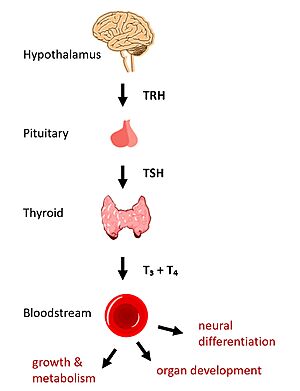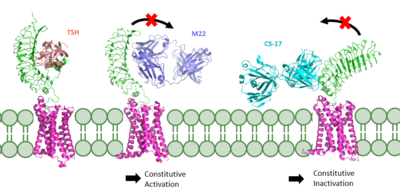Sandbox Reserved 1774
From Proteopedia
(Difference between revisions)
m (Reverted edits by Hannah E. Beaven (Talk); changed back to last version by Anastasia Severson) |
|||
| Line 13: | Line 13: | ||
Dysregulation of TSHR can lead to disease. In [https://www.niddk.nih.gov/health-information/endocrine-diseases/graves-disease#:~:text=Graves'%20disease%20is%20an%20autoimmune,the%20way%20your%20heart%20beats. Grave's disease], antibody analogs of TSH cause overactivation of TSHR, leading to clinical symptoms of hyperthyroidism <ref name="Chu" />. In contrast, congenital mutations which inactivate TSHR can lead to hypothyroidism, which results in growth retardation and neurologic impairment if left untreated <ref name="Brent" />. | Dysregulation of TSHR can lead to disease. In [https://www.niddk.nih.gov/health-information/endocrine-diseases/graves-disease#:~:text=Graves'%20disease%20is%20an%20autoimmune,the%20way%20your%20heart%20beats. Grave's disease], antibody analogs of TSH cause overactivation of TSHR, leading to clinical symptoms of hyperthyroidism <ref name="Chu" />. In contrast, congenital mutations which inactivate TSHR can lead to hypothyroidism, which results in growth retardation and neurologic impairment if left untreated <ref name="Brent" />. | ||
| - | == | + | == Molecular Structure and Function of TSHR == |
| - | + | === Key Players: TSHR Domains === | |
| + | To understand how the structure of TSHR contributes to its function, it is helpful to first become familiar with the three main domains of TSHR. First is the <scene name='95/952703/Tmd/9'>extracellular domain</scene> shown in green, which is concave in shape. It is also called the leucine rich region because it is made primarily of beta sheets which are rich in leucine <ref name="Kleinau">Kleinau G, Worth CL, Kreuchwig A, et al. Structural–Functional Features of the Thyrotropin Receptor: A Class A G-Protein-Coupled Receptor at Work. Frontiers in Endocrinology. 2017;8. Accessed April 2, 2023. [https://doi.org/10.3389/fendo.2017.00086 DOI: 10.3389/fendo.2017.00086]</ref>. This domain also contains lysine residues which play a key role in binding. Second is the <scene name='95/952703/Tmd/10'>transmembrane domain</scene> shown in pink. This domain is made up of seven helices and undergoes a conformation change upon ligand binding that activates the GPCR signal cascade <ref name="Duan" />. The third region of the TSHR is the <scene name='95/952703/Tmd/11'>hinge region</scene>, which plays a key role in the movement and stability of the TSHR. The details of the hinge mechanism are discussed in the proceeding section. | ||
| - | + | === Importance of Hinge Region to Signaling Activation === | |
| - | === Hinge | + | The TSHR hinges between two states: <scene name='95/952702/Overlay/2'>active and inactive</scene>. When the extracellular domain is hinged down, the receptor is inactive and no signaling activation occurs. When the extracellular domain raises into the upright position, the hinge region deforms and interacts with the extracellular loops to cause a conformation change in the TM domain and corresponding G-protein activation <ref name="Bruser">Bruser A, Schulz A, Rothemund S, et al. The Activation Mechanism of Glycoprotein Hormone Receptors with Implications in the Cause and Therapy of Endocrine Diseases. J Biol Chem. 2016;291(2):508-520. [https://doi.org/10.1074/jbc.M115.701102 DOI:10.1074/jbc.M115.701102]</ref>. While transition between the active and inactive states occurs spontaneously, favoring of one state over the other is influence by hinge interactions and ligand binding <ref name="Faust">PMID:35940205</ref>. When stabilized in the upright conformation, the activated GPCR signaling pathway results in transcription of thyroid hormones T3 and T4 (Fig. __) <ref name="Chu" />. |
| - | + | ||
| - | + | Modulation of TSHR signaling would not be possible without the hinge region, which accommodates up-and-down rotation of the extracellular domain as a rigid body about an imaginary 55 degree axis <ref name="Faust" />. During this transition, the hinge region undergoes <scene name='95/952702/P10_movement/2'>slinky-like deformation</scene> and is displaced approximately 5 Angstroms upward as it uncoils <ref name="Faust" />. The hinge region pulls on the linked transmembrane helices as it stretches, shifting TM helix 7 approximately 4 Angstroms inward and leading to G-protein signaling activation <ref name="Faust" />, <ref name="Bruser" />. | |
| - | + | ||
| - | + | ||
| - | + | ||
=== Stabilizing Interactions in the Hinge === | === Stabilizing Interactions in the Hinge === | ||
Revision as of 03:21, 14 April 2023
| This Sandbox is Reserved from February 27 through August 31, 2023 for use in the course CH462 Biochemistry II taught by R. Jeremy Johnson at the Butler University, Indianapolis, USA. This reservation includes Sandbox Reserved 1765 through Sandbox Reserved 1795. |
To get started:
More help: Help:Editing |
| |||||||||||


